30-Day In Australia: Adventure Itinerary
From Darwin to Adelaide, here's an epic 30 day travel itinerary in the land down under.
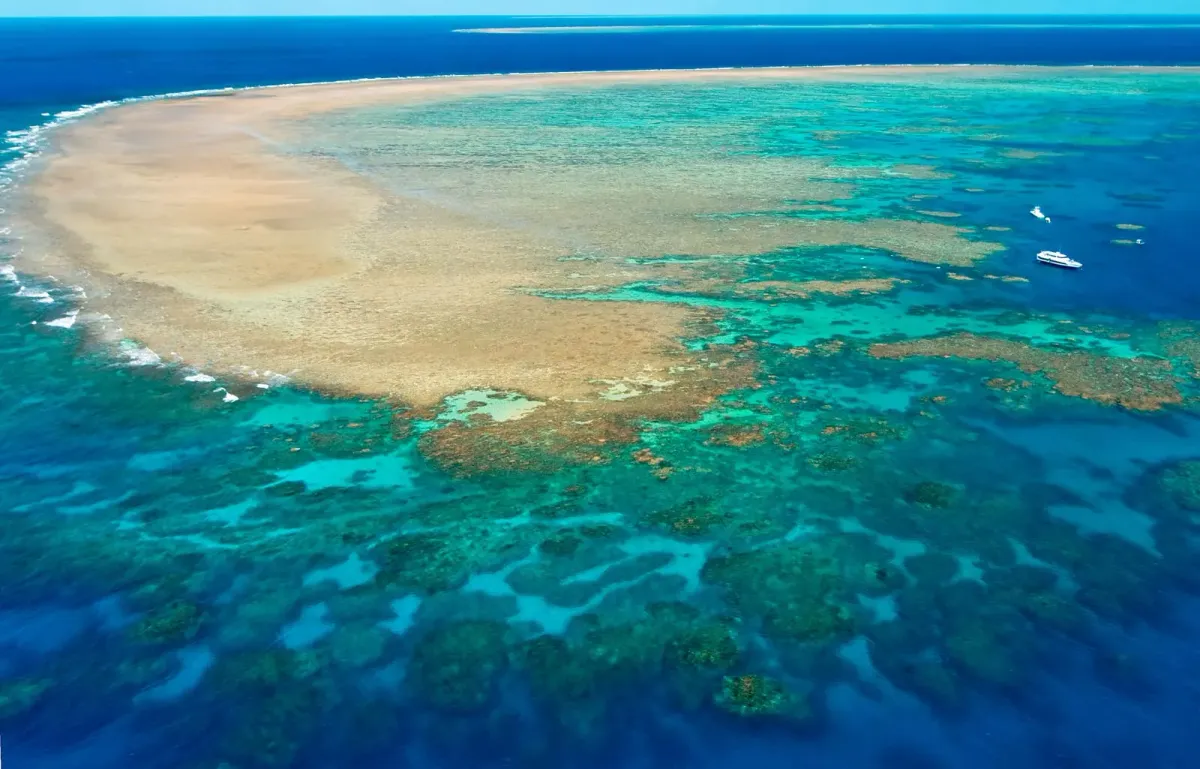
This 30-day Australia travel itinerary is designed for travelers who want to experience the country’s most beautiful and wild places. You’ll go from the tropical Top End in Darwin, through ancient rainforests, coral reefs, desert outposts, and rugged national parks—all the way to the southern coast in Adelaide.
✈️ Pro Tip: Since Australia is huge, book a multi-destination flight: arrive in Darwin and depart from Adelaide, or reverse the order if the fare is cheaper. This itinerary is written starting in Darwin, but you can easily flip it if needed.
| Day(s) | Destination |
|---|---|
| Days 1–3 | Darwin & Kakadu National Park |
| Days 4–6 | Cairns, Daintree & Great Barrier Reef |
| Days 7–9 | Whitsundays |
| Days 10–11 | Gold Coast & Hinterland |
| Days 12–13 | Sydney |
| Days 14–15 | Melbourne |
| Days 16–17 | Great Ocean Road |
| Days 18–19 | Grampians National Park (Gariwerd) |
| Days 20–21 | Mount Gambier |
| Days 22–24 | Coorong National Park & Fleurieu Peninsula |
| Days 25–27 | Kangaroo Island |
| Days 28–29 | Adelaide |
| Day 30 | Depart For Home |
Days 1–3: Darwin & Kakadu
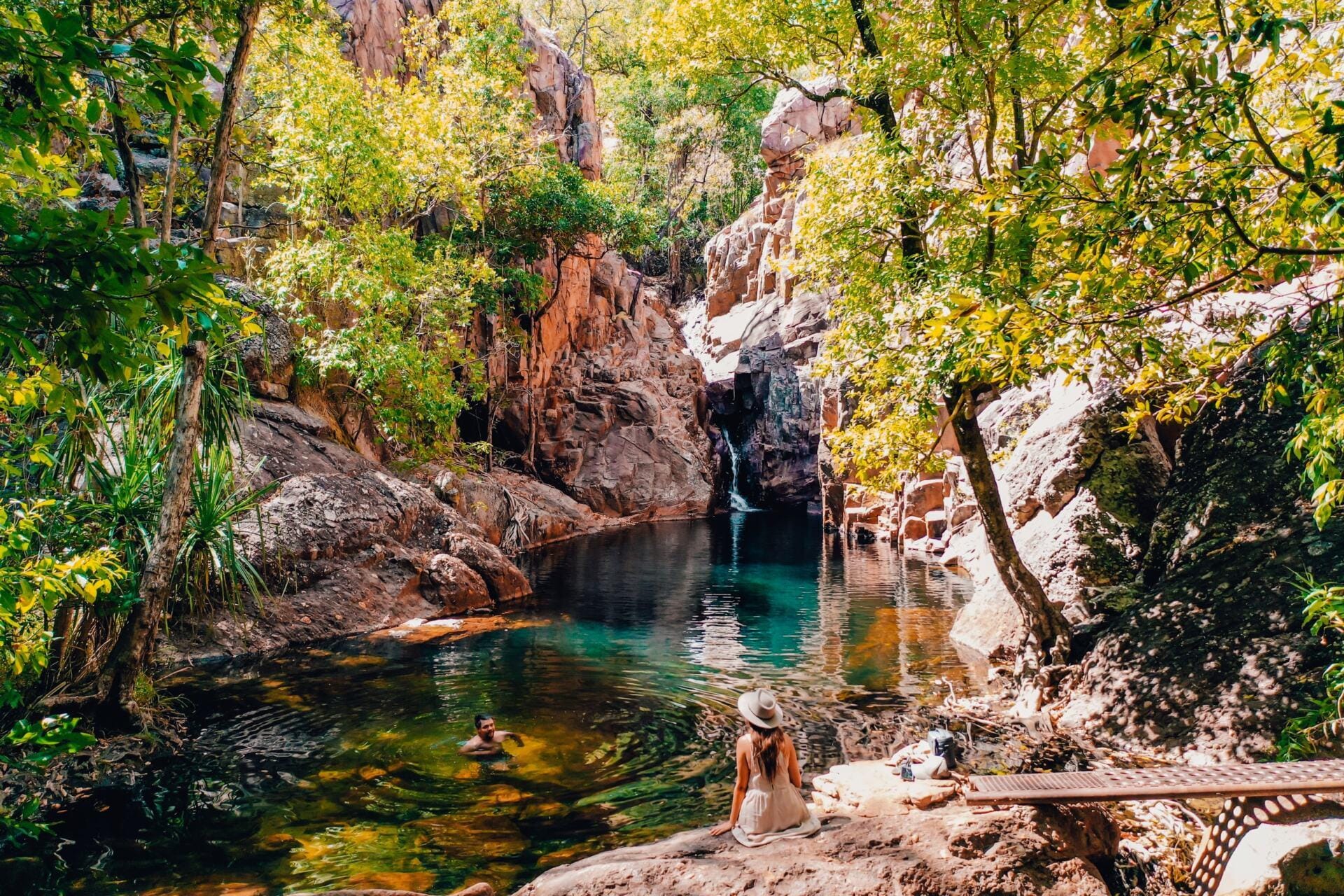
This leg of the trip introduces you to Australia's tropical north. You’ll explore Darwin’s laid-back vibe, then dive deep into the ancient landscapes, rock art, and wetlands of Kakadu National Park—home to crocs, waterfalls, and Indigenous culture.
Tropical Top End energy meets ancient landscapes—Darwin gives you laid-back waterfront life, and Kakadu delivers sweeping wetlands, towering escarpments, and rock art that tells stories tens of thousands of years old.
The Scenery
- Darwin — palm-lined foreshore, glowing sunsets over the Timor Sea, and a harbor bigger than Sydney’s.
- Kakadu National Park — dramatic sandstone cliffs, paperbark swamps, floodplains teeming with birdlife, and seasonal waterfalls that thunder after the rains.
- Expect crocodile-country waterways, lotus-dotted billabongs, and vast skies—sunrise and sunset are next-level.
The Vibe
- Darwin feels easygoing and social—cold drinks at sunset, live music, and a come-as-you-are crowd. Beaches look tempting but swimming is limited due to stingers (seasonal) and crocodiles—use the lagoon or pools.
- Kakadu is slower and immersive—early mornings for wildlife, heat-of-day siestas, and golden-hour hikes. It’s about respect for Country, big landscapes, and time outdoors.
Day 1 — Darwin
- Morning/Afternoon: Stroll the Darwin Waterfront & Lagoon for a safe swim and coffee by the water. Explore the Museum and Art Gallery of the Northern Territory for Aboriginal art and Cyclone Tracy history.
- Evening: Head to Mindil Beach Sunset Market (seasonal) for food stalls and that famous sunset, or grab a seat at Deckchair Cinema for an outdoor movie.
Day 2 — Kakadu (Ubirr & Yellow Water)
- Morning: Drive toward Kakadu (about 3 hours). Stop at the Bowali Visitor Centre for maps and updates.
- Midday: Visit Ubirr for Aboriginal rock art galleries and climb to the lookout for sweeping floodplain views.
- Evening: Take a Yellow Water Billabong sunset cruise—watch for crocodiles and birdlife in golden light.
Day 3 — Kakadu (Waterfalls & Nourlangie)
- Morning: Explore Burrungkuy (Nourlangie) for more rock art and the Anbangbang Lookout.
- Afternoon: If it’s dry season and you’ve got 4WD, head to Jim Jim Falls or Twin Falls—iconic cliff walls and plunge pools. Alternative: Maguk for a refreshing waterfall swim.
- Evening: Return toward Darwin or stay overnight in Kakadu depending on your pace.
Days 4–6: Cairns, Daintree & Great Barrier Reef
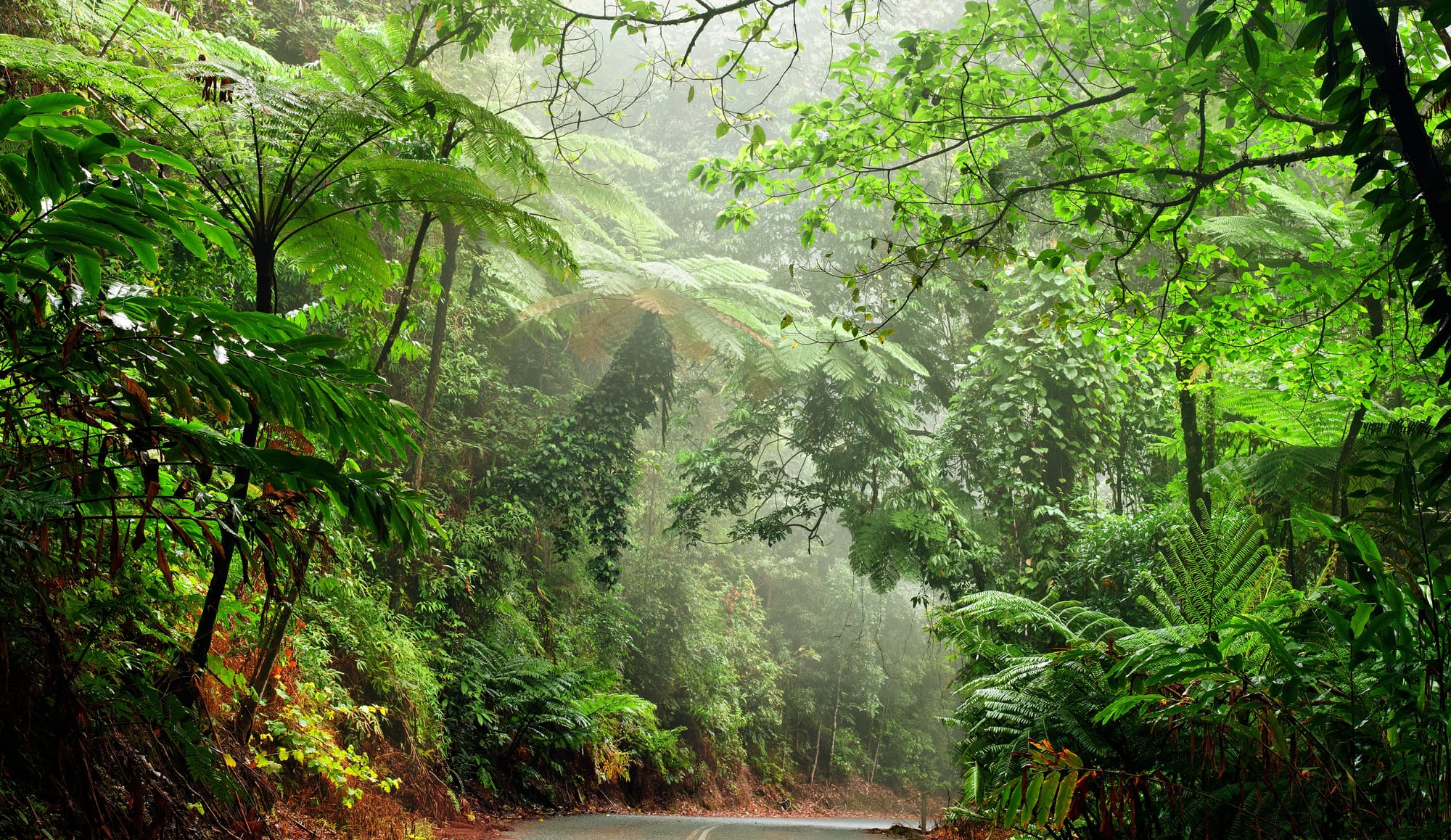
Fly to Cairns, the gateway city to the Great Barrier Reef and the Daintree National Park—two of Australia’s most famous natural wonders. It’s the perfect base for reef trips, rainforest adventures, and a taste of tropical north Queensland.
The Scenery
- The Great Barrier Reef stretches out offshore—an underwater world of coral gardens, sea turtles, reef sharks, and dazzling tropical fish.
- Just north of Cairns, the Daintree Rainforest is one of the oldest rainforests on earth, with ancient ferns, waterfalls, and thick jungle that feels prehistoric.
- The coastline is dotted with palm-fringed beaches and river estuaries where rainforest meets the sea.
The Vibe
- Cairns itself has a laid-back, tropical feel with a strong backpacker scene—hostels, open-air bars, and the lively Esplanade Lagoon where locals and travelers hang out.
- The Daintree is the opposite—remote, wild, and quiet, offering a deep nature experience.
- The mix of reef and rainforest makes this stretch of Queensland unlike anywhere else in Australia.
Day 4 — Cairns & Kuranda
- Morning: Ride the Skyrail Rainforest Cableway or the scenic railway up to Kuranda. Explore the markets and wildlife parks.
- Afternoon: Return to Cairns and cool off at the Esplanade Lagoon or visit Crystal Cascades swimming hole.
- Evening: Casual dinner on the Esplanade—lots of open-air options.
Day 5 — Great Barrier Reef
- Full Day: Take a boat to the outer reef for snorkeling or diving. Expect coral gardens, turtles, and colorful fish. Liveaboard diving trips are an option if you want longer reef time.
- Evening: Back in Cairns, enjoy the lively nightlife or keep it low-key with a harborfront dinner.
Day 6 — Daintree & Cape Tribulation
- Morning: Drive north to the Daintree River—take a crocodile-spotting cruise.
- Midday: Cross the ferry and explore the Daintree Rainforest—walk the Marrdja Boardwalk or Jindalba Walk.
- Afternoon: Continue to Cape Tribulation where reef meets rainforest; stroll the beach and enjoy the remoteness.
- Evening: Return to Cairns or stay overnight in the Daintree for a deeper experience.
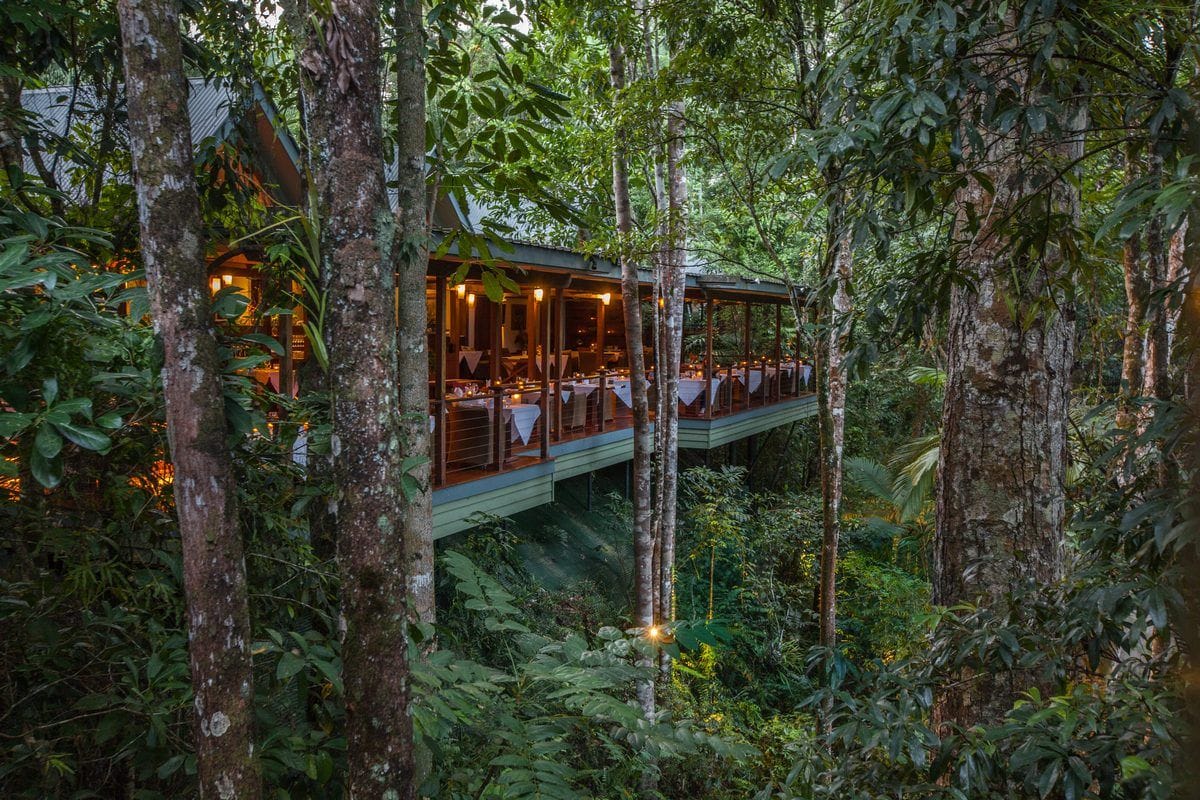
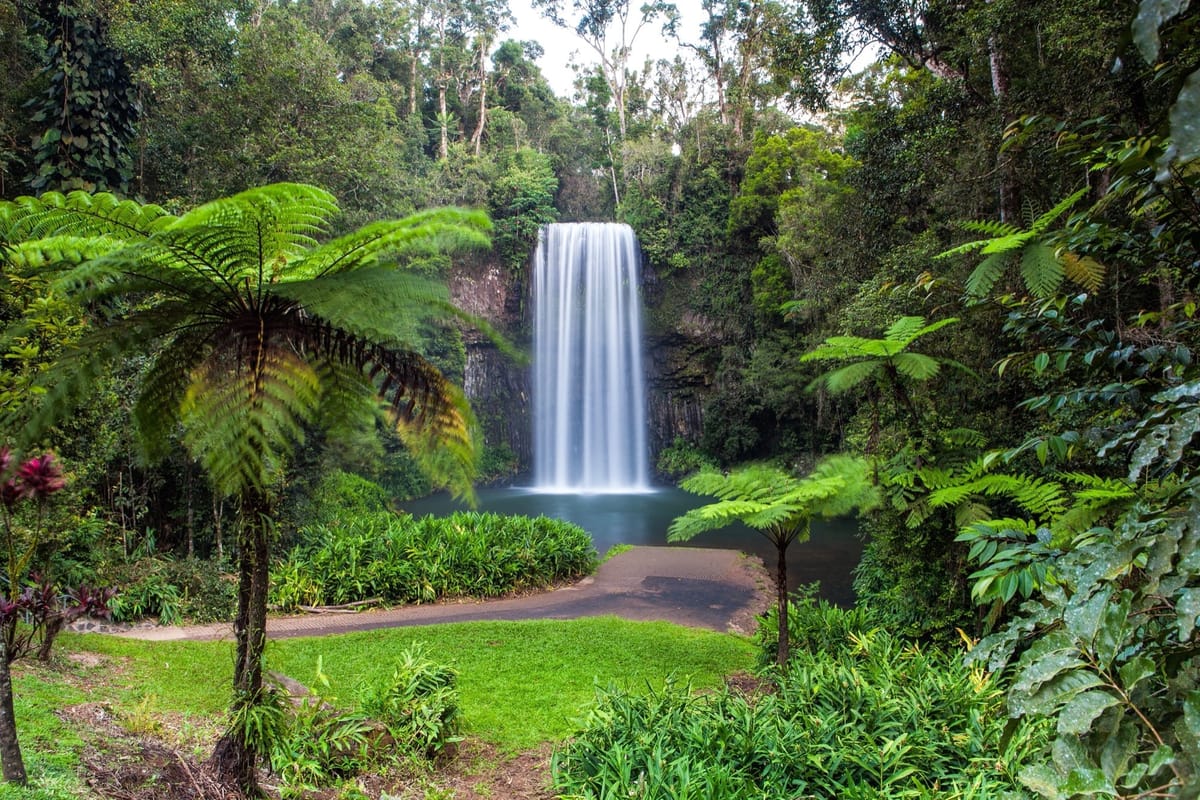
How do I get from Darwin to the Whitsundays?
The Easy Way (Most People Do This)
- Fly Darwin → Brisbane → Whitsundays
- From Darwin Airport (DRW), fly to Brisbane (BNE). This takes about 4 hours.
- From Brisbane, catch a 1.5-hour flight to either:
- Hamilton Island Airport (HTI) — right in the Whitsundays. You step off the plane and you’re there.
- Proserpine Airport (PPP) — about 30 minutes from Airlie Beach, where ferries to the islands leave.
- Total travel time: around 6–7 hours including connections.
The Faster (But Sometimes More Expensive) Way
- Fly Darwin → Cairns → Whitsundays
- Take a 2.5-hour flight from Darwin to Cairns.
- From Cairns, it’s just a 1.5-hour flight to Hamilton Island or Proserpine.
- This route is shorter in the air, but not as many flights line up — so it depends on schedules.
The Hard Way (Not Recommended Unless Road-Tripping)
- Drive from Darwin to Airlie Beach — about 30–35 hours of driving (2,800 km).
- That’s basically several full days in the car across the Outback. Only worth it if you want the road trip adventure of a lifetime.
✅ Best Option for Most Travelers: Fly Darwin → Brisbane → Whitsundays. It’s the simplest, most reliable way to go.
Days 7–9:
Whitsundays & Airlie Beach
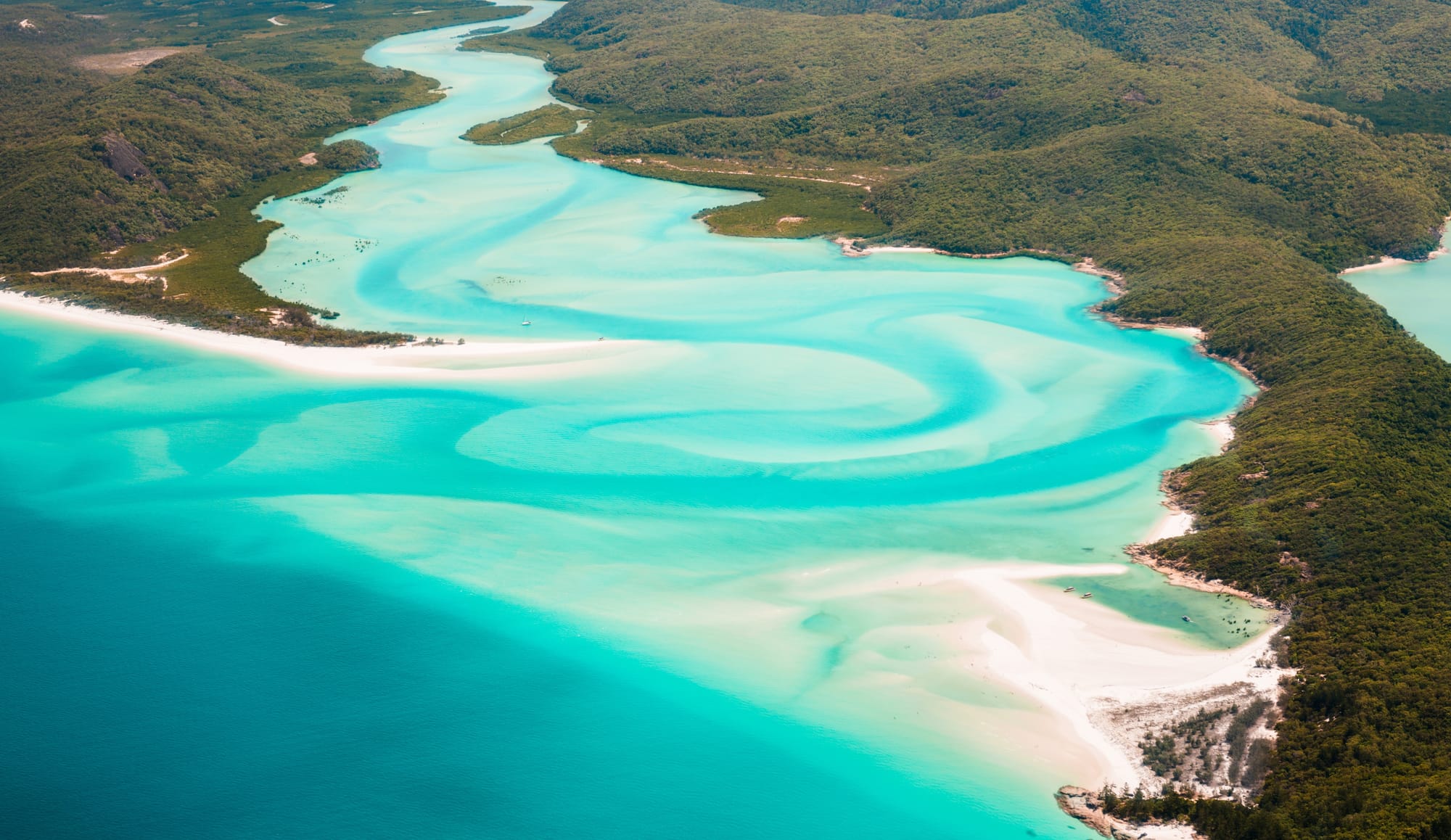
The Whitsundays are one of Australia’s most stunning destinations—basically a collection of 74 islands scattered across the heart of the Great Barrier Reef, off the coast of Queensland. They’re famous for white sand beaches, turquoise waters, and that perfect postcard look you probably imagine when you think of a tropical paradise.
The Scenery
- Whitehaven Beach is the star—it’s consistently ranked as one of the most beautiful beaches in the world thanks to its pure white silica sand that squeaks under your feet.
- The water is every shade of blue you can imagine, from light aqua to deep sapphire.
- Most islands are covered in lush rainforest and fringed with coral reefs, so it feels wild and untouched once you get away from the main resorts.
The Vibe
- Airlie Beach on the mainland is the gateway town—it’s where most tours depart and where the backpacker party scene is.
- On the islands themselves, you’ll find everything from luxury resorts (like Hamilton Island) to eco-retreats and even uninhabited islands you can camp on.
- It’s relaxed, outdoorsy, and very much about the water—boats, beaches, and reefs are what people come for.
Day 7 — Arrival & Airlie Beach
- Morning/Afternoon: Fly into Proserpine or Hamilton Island, transfer to Airlie Beach. Stroll the Airlie Lagoon and marina.
Day 8 — Sailing & Whitehaven Beach
- Full Day: Join a sailing trip around the islands. Visit Whitehaven Beach—the silica sand and swirling turquoise water at Hill Inlet are unforgettable.
- Optional: Go snorkeling at fringing reefs off Hook or Hayman Island.
- Evening: Return to Airlie or stay on a liveaboard boat.
Day 9 — Scenic Flights & Island Time
- Morning: Take a scenic flight over Heart Reef—the famous coral heart formation.
- Afternoon: Spend time on an island resort like Hamilton Island (with golf carts, cafes, and wildlife) or Daydream Island (known for its Living Reef lagoon).
- Evening: Relax with a sunset drink overlooking the water.
- Evening: Dinner along the main strip—Airlie has a lively backpacker vibe if you want nightlife.
How to get from the Whitsundays to the Gold Coast?
The Easy Way (Most Travelers Do This)
- Fly Whitsundays → Brisbane → Train to Gold Coast
- From Hamilton Island Airport (HTI) or Proserpine Airport (PPP near Airlie Beach), take a short 1.5 hour flight to Brisbane (BNE).
- From Brisbane Airport, hop on the Airtrain straight to the Gold Coast. It’s about 1.5–2 hours and drops you in Surfers Paradise, Broadbeach, or Helensvale.
- Total travel time: 3.5–5 hours.
The Faster (But Less Frequent) Way
- Fly Whitsundays → Gold Coast Airport (OOL)
- There aren’t always direct flights, but you can sometimes connect via Brisbane or Sydney.
- Once you land at Gold Coast Airport, you’re already at the beach — Surfers Paradise is only 30 minutes away by car or shuttle.
The Hard Way (Skip Unless You Love Driving)
- Drive from Airlie Beach to the Gold Coast — about 14–15 hours (1,200 km).
- Or take a Greyhound bus — but that’s a 22–25 hour trip. Way too long unless you’re purposely doing a road trip.
Days 10–11:
Gold Coast & Hinterland
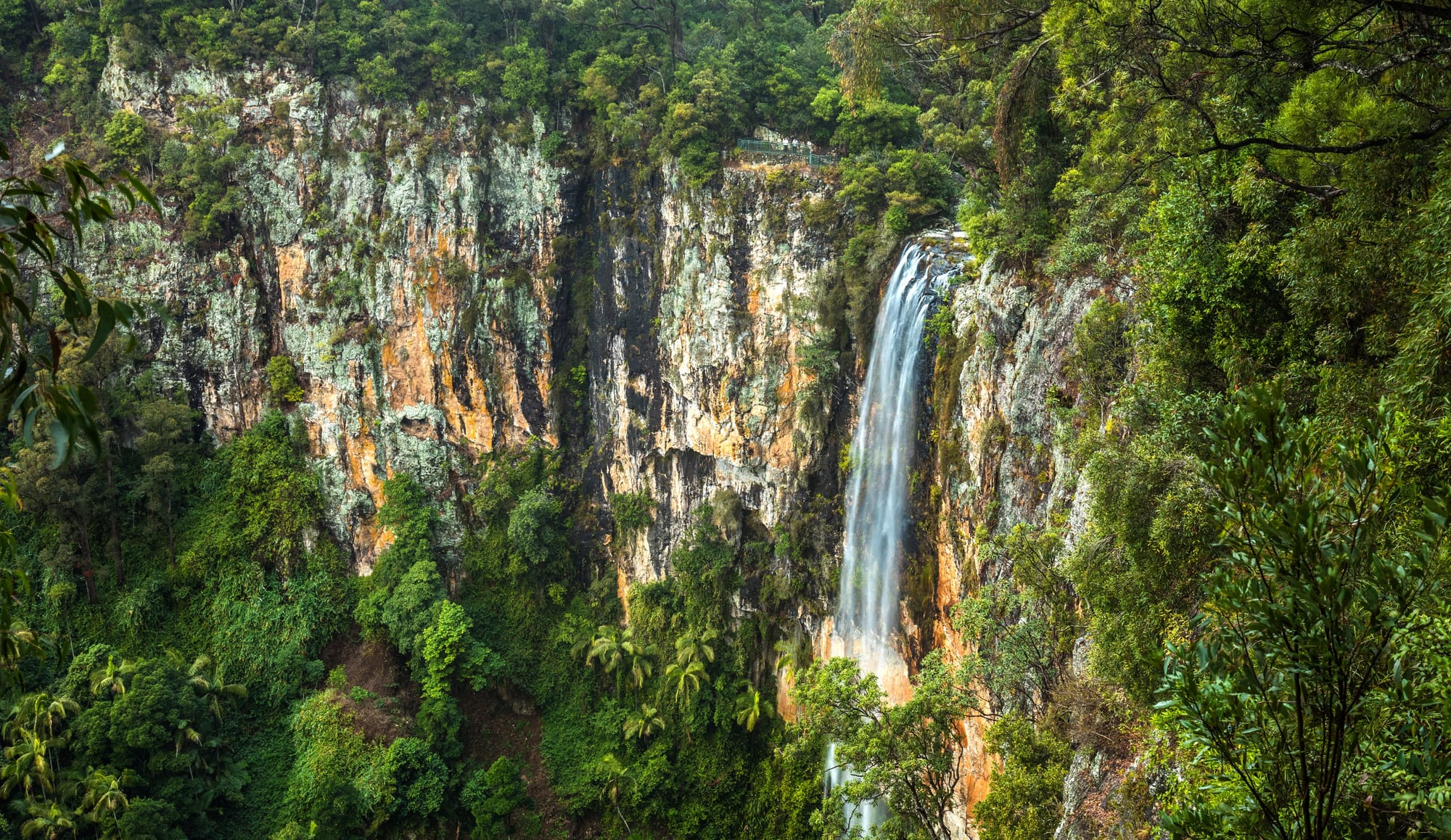
Two days on the Gold Coast gives you world-class beaches, skyline views from Q1, and rainforest waterfalls just inland—easy, sunny, and packed with things to do.
The Scenery
- A long sweep of golden sand from Main Beach to Coolangatta—headlands, pandanus, and clean, surfable breaks.
- A city-meets-sea skyline—best from SkyPoint Observation Deck—with calm creeks like Tallebudgera feeding the coast.
- Just inland, the Gold Coast Hinterland rises into cool rainforest—Springbrook and Lamington bring waterfalls, glow-worm caves, and ancient Gondwana flora.
The Vibe
- Coast: sunrise swims, boardshorts-and-cafés, and a lively after-dark strip in Surfers Paradise. Burleigh feels local and laid back; Broadbeach is polished.
- Hinterland: slower, greener, and quiet—small mountain villages, cellar doors, and shaded trails that feel a world away from the beach.
Day 10 — Gold Coast: Beaches, Burleigh & SkyPoint
- Morning: Swim at Burleigh Heads Beach, then walk the ocean view track in Burleigh Head National Park—watch for turtles from the headland. Coffee with a sea breeze.
- Midday: Pick your vibe:
- Tallebudgera Creek for calm water and a paddleboard session, or
- Currumbin Wildlife Sanctuary to feed lorikeets and meet koalas.
- Afternoon: Roll into Broadbeach—lunch and a quick browse at Pacific Fair, or a chilled hour on Kurrawa Beach. Theme-park fans can swap this block for Sea World/Movie World/Dreamworld.
- Golden hour: Ride up SkyPoint (Q1) for sunset—coastline one way, hinterland the other.
- Evening: Stroll Surfers Paradise foreshore for dinner and lights, or head back to Burleigh for a mellow beachside bite. On weekends, Miami Marketta is a fun street-food stop.
Day 11 — Gold Coast Hinterland: Springbrook, Tamborine & Lamington
- Morning: Drive to Springbrook National Park. Do the Natural Bridge loop first—short and photogenic—then the Purling Brook Falls circuit for rainforest cliffs and spray. Detour to Best of All Lookout for big valley views.
- Midday: Continue to Tamborine Mountain—lunch on Gallery Walk, stroll to Curtis Falls, and, if you want, the Tamborine Rainforest Skywalk.
- Afternoon (Option A): Keep it easy—visit a winery or two, then return to the coast for a late swim.
- Afternoon (Option B): Go deeper into Lamington National Park (O’Reilly’s or Binna Burra) for short trails, the Tree Top Walk, and lookouts like Morans Falls. Start back before dusk—roads are narrow and wildlife gets active.
- Evening: Coastal dinner and a beach walk. If you’re staying up top, a guided glow-worm tour at Natural Bridge is a great night cap.
How do I get from the Gold Coast to Sydney?
The Easy Way (Most People Do This)
- Fly Gold Coast → Sydney
- Gold Coast Airport (OOL) has direct flights to Sydney (SYD).
- The flight takes about 1.5 hours — basically the same time it takes to watch a movie.
- Qantas, Virgin, and Jetstar all fly this route daily, so you’ve got plenty of options.
- Once you land in Sydney, you’re right there in the city within 30 minutes by train, taxi, or rideshare.
The Scenic Way
- Drive the Pacific Highway (A1)
- The drive is about 9–10 hours nonstop.
- But most people turn it into a road trip with overnight stops.
- Highlights along the way include Byron Bay, Coffs Harbour, and Port Macquarie.
- Great option if you want beaches, small coastal towns, and that classic Aussie road trip feel.
The Relaxed Way
- Train from Gold Coast to Sydney
- Catch a train to Brisbane first, then hop on the XPT service to Sydney.
- Total travel time: around 14 hours — so it’s slower, but comfy if you like trains.
- You can book sleeper cabins for an overnight ride.
✅ Best Option for Most Travelers: Flying — quick, easy, and often cheaper than driving once you factor in fuel and time.
Days 12–13:
Sydney
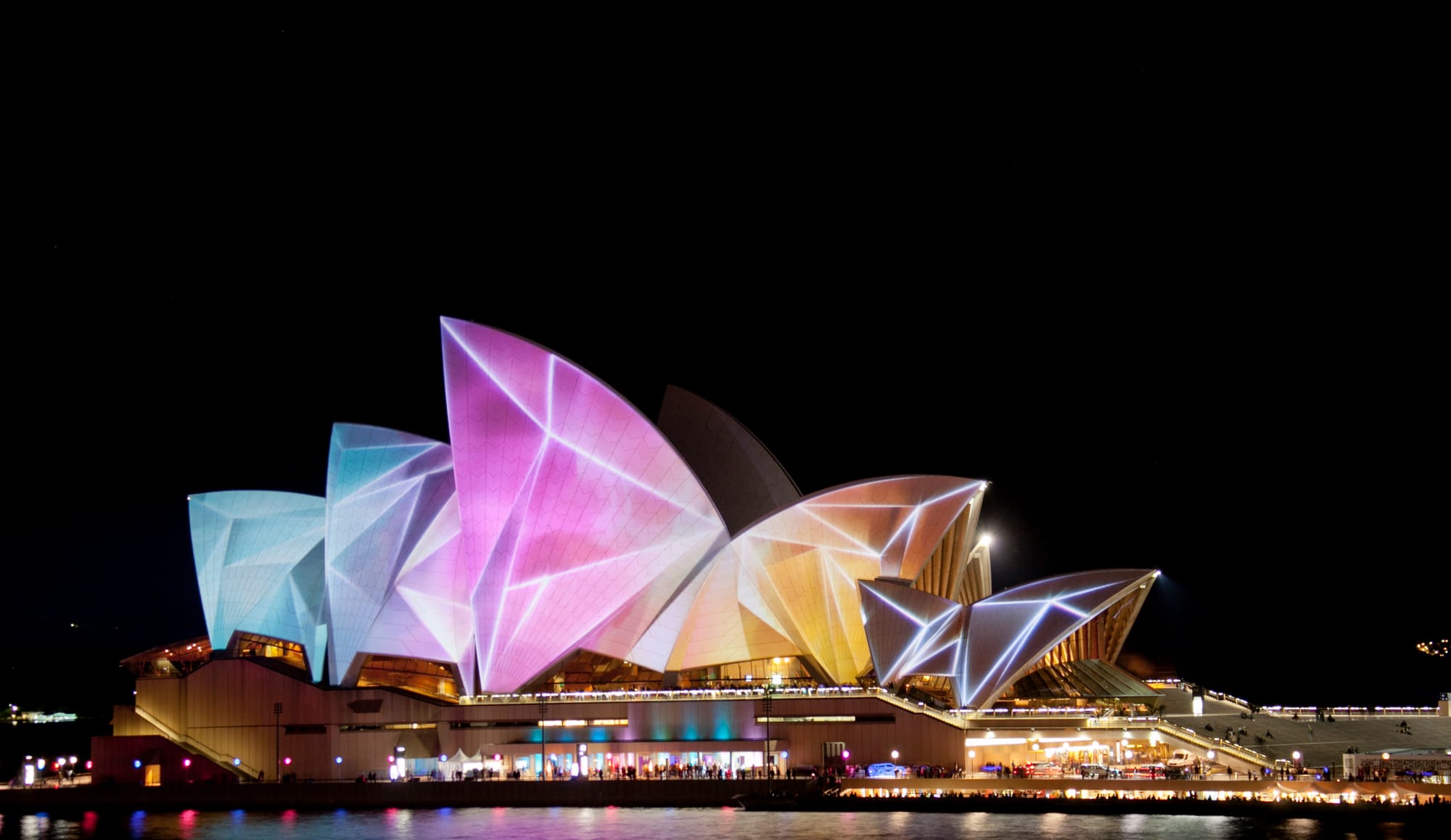
Though only here for two days, you’ll get to see Sydney’s most iconic sights. Expect a mix of coastal walks, harbor views, and world-famous landmarks.
The Scenery
- Melbourne is a city of contrasts—modern skyscrapers alongside historic laneways covered in colorful street art.
- The Yarra River winds through the city, lined with bars and restaurants. Just beyond the skyline, you’ll find leafy parks, trendy neighborhoods, and a famous café culture.
- Day trips reveal natural beauty—the Great Ocean Road with its cliffs and Twelve Apostles, and the Yarra Valley with rolling vineyards.
The Vibe
- Melbourne is Australia’s cultural capital—art, music, sports, and food drive the rhythm of the city.
- It’s stylish yet relaxed—locals live for coffee, AFL footy, and discovering hidden gems down narrow laneways.
- Each neighborhood feels different: hip Fitzroy, elegant South Yarra, or seaside St Kilda.
Day 14 — City Icons & Laneway Life
- Morning: Begin at Federation Square and stroll to Flinders Street Station—two Melbourne landmarks. From here, explore the laneways: Hosier Lane for street art, Degraves Street for coffee, and Block Arcade for heritage shopping.
- Midday: Visit the National Gallery of Victoria (NGV) or ACMI (film and digital culture). Lunch at a laneway café or head to Queen Victoria Market for local flavors.
- Afternoon: Walk the Yarra River promenade at Southbank, or take a ride on the Melbourne Star Observation Wheel for city views.
- Evening: Catch a performance at the Arts Centre Melbourne or see what’s on at the Melbourne Cricket Ground (MCG) if sports are in season. Dine in Chinatown or try the city’s thriving Asian-fusion restaurants.
Day 15 — Coastal & Cultural Melbourne
- Morning: Tram out to St Kilda—stroll the pier, see the resident penguins (at dusk if you return later), and grab brunch at Acland Street’s bakeries.
- Midday: Head to Royal Botanic Gardens for a walk among native and international plant collections, or take a guided Aboriginal Heritage Walk.
- Afternoon (Option A): Join a half-day wine tour to the Yarra Valley—known for chardonnay, pinot noir, and cheese tastings.
- Afternoon (Option B): Stick closer to the city—explore Fitzroy and Collingwood for vintage shops, murals, and craft breweries.
- Evening: Return to the city for rooftop drinks—Naked in the Sky or Madame Brussels are local favorites. Wrap up your Melbourne stay with a late-night tram ride through the city’s neon-lit streets.
How Do I Get From Sydney to Melbourne?
The Easy Way (Most People Do This)
- Fly Sydney → Melbourne (MEL)
- Flight time: ~1.5 hours.
- Tons of daily flights on Qantas, Virgin, and Jetstar.
- You’ll land at Melbourne Tullamarine (MEL); grab the SkyBus to Southern Cross Station (about 30–40 min) or a rideshare/taxi.
- Sometimes Jetstar also flies into Avalon (AVV)—that’s farther from the city, so only pick it if the fare is crazy cheap.
The Fastest Drive
- Inland via the Hume Highway (M31)
- Distance/time: ~880 km, 9–10 hours without long stops.
- Easiest navigation—straight shot with plenty of service stations.
- Good stop ideas: Goulburn, Albury–Wodonga, Glenrowan (Ned Kelly history).
The Scenic Road Trip
- Coastal route via the Grand Pacific Drive + Princes Highway
- Distance/time: ~1,000+ km; plan 2–3 days to actually enjoy it.
- Highlights: Sea Cliff Bridge, Jervis Bay (white-sand beaches), Narooma and the Sapphire Coast, Gippsland Lakes.
- This is the “wow” route—beaches, headlands, small towns—way prettier, but slower.
The Chill, No-Flying Option
- Train (NSW TrainLink XPT)
- Time: ~11 hours.
- Day or overnight services most days; big reclining seats (no sleeper cabins).
- Departs Sydney’s Central Station, arrives Southern Cross in Melbourne—city center to city center.
- Coach (overnight bus)
- Time: ~12 hours (varies by operator/date).
- Cheapest way to travel last minute, but the least comfortable.
Days 14–15:
Melbourne
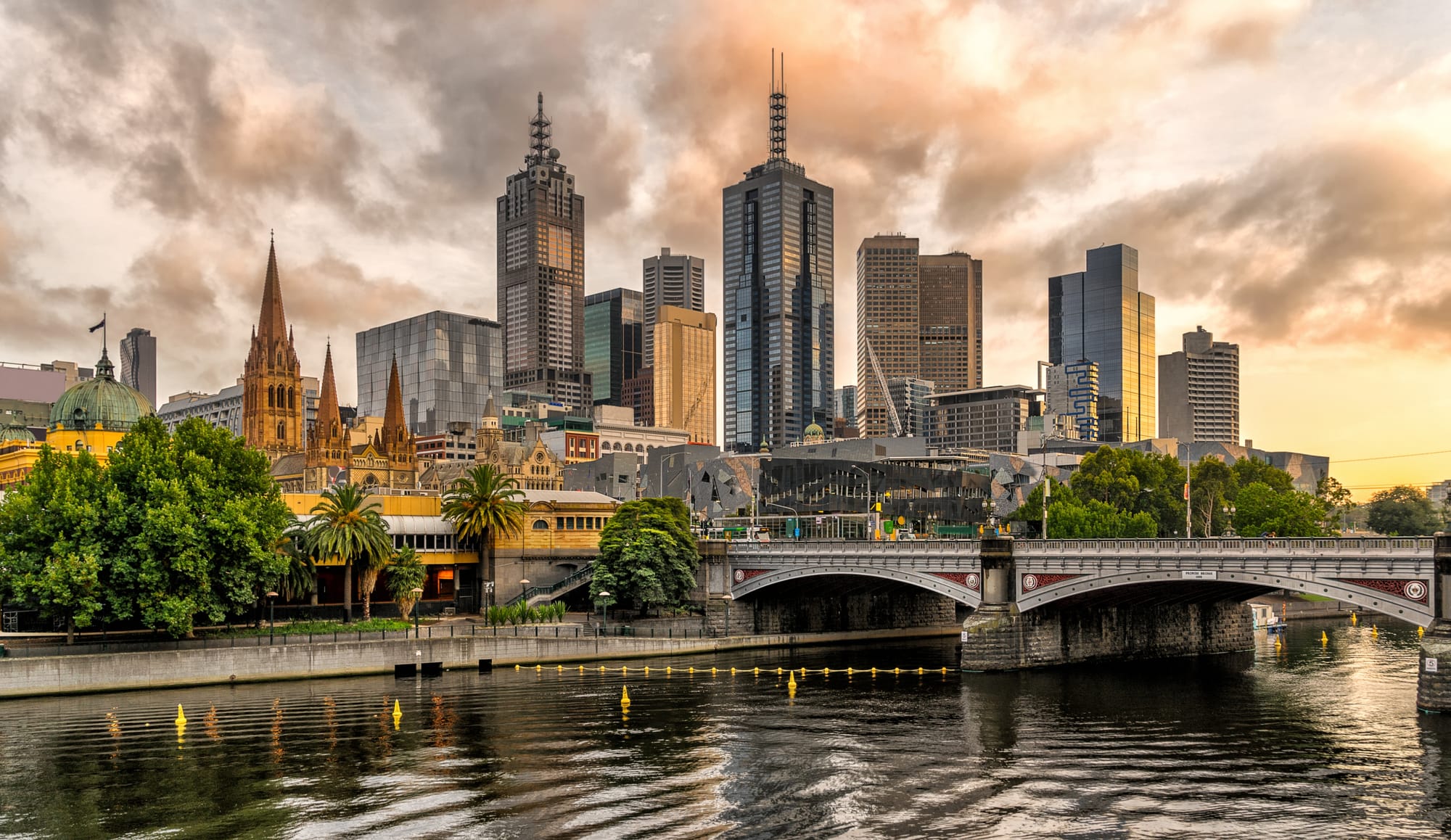
You’ll spend two days enjoying the coffee, art, and food of one of Australia’s most beloved cities before heading off to begin the nature-filled road trip to Adelaide.
The Scenery
- Melbourne is a city of contrasts—modern skyscrapers alongside historic laneways covered in colorful street art.
- The Yarra River winds through the city, lined with bars and restaurants. Just beyond the skyline, you’ll find leafy parks, trendy neighborhoods, and a famous café culture.
- Day trips reveal natural beauty—the Great Ocean Road with its cliffs and Twelve Apostles, and the Yarra Valley with rolling vineyards.
The Vibe
- Melbourne is Australia’s cultural capital—art, music, sports, and food drive the rhythm of the city.
- It’s stylish yet relaxed—locals live for coffee, AFL footy, and discovering hidden gems down narrow laneways.
- Each neighborhood feels different: hip Fitzroy, elegant South Yarra, or seaside St Kilda.
Day 14 — City Icons & Laneway Life
- Morning: Begin at Federation Square and stroll to Flinders Street Station—two Melbourne landmarks. From here, explore the laneways: Hosier Lane for street art, Degraves Street for coffee, and Block Arcade for heritage shopping.
- Midday: Visit the National Gallery of Victoria (NGV) or ACMI (film and digital culture). Lunch at a laneway café or head to Queen Victoria Market for local flavors.
- Afternoon: Walk the Yarra River promenade at Southbank, or take a ride on the Melbourne Star Observation Wheel for city views.
- Evening: Catch a performance at the Arts Centre Melbourne or see what’s on at the Melbourne Cricket Ground (MCG) if sports are in season. Dine in Chinatown or try the city’s thriving Asian-fusion restaurants.
Day 15 — Coastal & Cultural Melbourne
- Morning: Tram out to St Kilda—stroll the pier, see the resident penguins (at dusk if you return later), and grab brunch at Acland Street’s bakeries.
- Midday: Head to Royal Botanic Gardens for a walk among native and international plant collections, or take a guided Aboriginal Heritage Walk.
- Afternoon (Option A): Join a half-day wine tour to the Yarra Valley—known for chardonnay, pinot noir, and cheese tastings.
- Afternoon (Option B): Stick closer to the city—explore Fitzroy and Collingwood for vintage shops, murals, and craft breweries.
- Evening: Return to the city for rooftop drinks—Naked in the Sky or Madame Brussels are local favorites. Wrap up your Melbourne stay with a late-night tram ride through the city’s neon-lit streets.
How do I get from Melbourne to the Great Ocean Road?
From Melbourne, the best option is to rent a car—this isn’t just for the Great Ocean Road, but for the rest of your trip through southern Australia.
Unlike the earlier parts of your itinerary, where flights were needed to cover massive distances (Darwin, Cairns, Whitsundays, Gold Coast, Sydney), the remaining destinations are all close enough to reach by car. Driving will give you the freedom to explore at your own pace and stop at the small towns, coastlines, and national parks along the way.
The Great Ocean Road officially begins in Torquay, about a 1.5–2 hour drive from Melbourne. From there, the road hugs the coastline through surf towns, rainforest, and dramatic limestone cliffs—including the iconic Twelve Apostles.
Renting a car in Melbourne means you can enjoy this stretch the way it was meant to be—slow, scenic, and full of stops whenever something catches your eye.
✅ Key takeaway: Pick up your rental car in Melbourne. From here on, every destination—Great Ocean Road, Grampians, Mount Gambier, Coorong, Fleurieu Peninsula, Kangaroo Island, and Adelaide—flows naturally into the next by road. No more long domestic flights, just beautiful drives through some of the most stunning landscapes in Australia.
Days 16–17:
Great Ocean Road
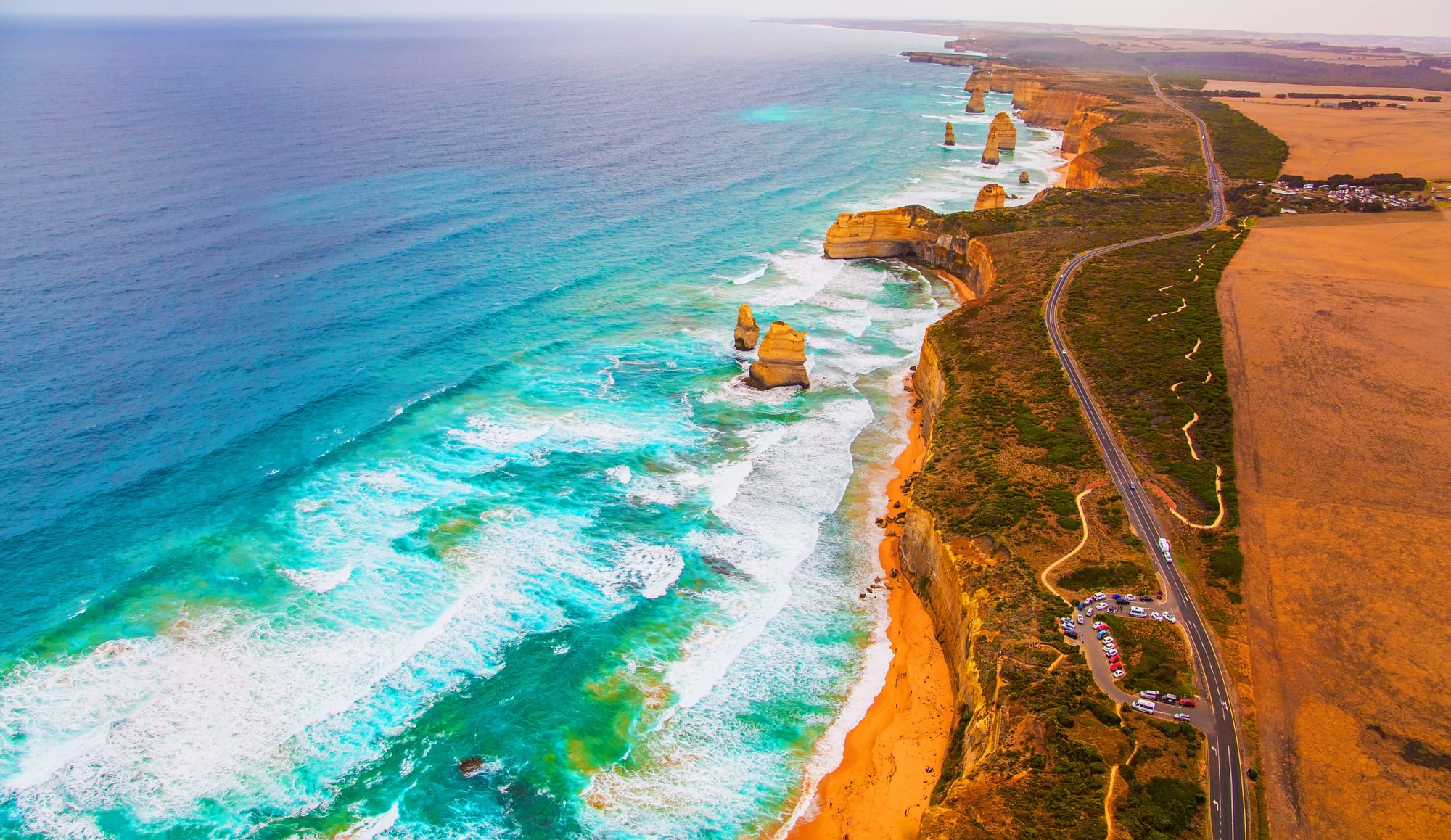
These next two days will take you along one of the most scenic drives in the world. Coastal cliffs, limestone stacks, and temperate rainforest make this stretch unforgettable.
The Scenery
- An iconic coastal drive—wave-cut cliffs, sea stacks, and long surf beaches from Torquay to Port Campbell.
- Cool, mossy rainforest in the Great Otway National Park—fern gullies, tree ferns, and waterfall walks.
- The headline sights—Twelve Apostles, Loch Ard Gorge, Gibson Steps, London Arch, The Grotto, Bay of Islands—all packed into a dramatic limestone coast.
The Vibe
- Easygoing surf towns, bakery stops, and lookouts every few minutes—this is a slow, scenic road trip, not a race.
- Wildlife is part of the day—koalas near Kennett River, swamp wallabies on rainforest roads, and birdlife around the Otways.
- Evenings are mellow—seafood, small-town pubs, and big sunsets over the Southern Ocean.
Day 16 — Great Ocean Road: Surf Coast to Apollo Bay
- Morning: Pick up the car and leave Melbourne early. Hit Torquay (Surf Coast capital), then stop at Bells Beach lookout. Grab your classic road photo at the Great Ocean Road Memorial Arch. Coffee in Lorne, then a quick detour to Teddy’s Lookout for cliff-meets-ocean views.
- Midday: Short rainforest fix at Erskine Falls (easy lookout; add the lower falls track if you want a leg-stretch). Lunch in Lorne or Wye River—both have solid cafes.
- Afternoon: Cruise the curvy coast to Kennett River—walk a little up Grey River Road to spot wild koalas. Roll into Apollo Bay; if you’ve got time, do the Maits Rest boardwalk for a first taste of Otways rainforest.
- Evening: Drive up to Marriners Lookout for a sunset over Apollo Bay and the crescent coast. Fresh seafood in town and an early night—tomorrow is your big limestone day.
- Driving guide: Melbourne→Torquay ~1.5 hours; Torquay→Apollo Bay ~2.5 hours without stops—plan the whole day with photo breaks.
Day 17 — Great Ocean Road: Otways Rainforest & Twelve Apostles
- Morning: Choose your flavor:
- Short & scenic: Stroll Maits Rest at first light, then detour to Cape Otway Lightstation for wild-coast views and more koala chances along Lighthouse Road.
- Waterfall option: Head inland to Triplet Falls or Hopetoun Falls (longer walks—lush and worth it if you love rainforest).
- Midday: Drive west to Gibson Steps—walk down to the beach (check tide/swell) to feel the scale of the cliffs. Continue to the Twelve Apostles boardwalk for the classic panorama.
- Afternoon: Explore the Loch Ard Gorge precinct—The Razorback, Tom and Eva Lookout, and the beach cove. Then hop-scotch to London Arch, The Grotto, Bay of Martyrs, and Bay of Islands near Peterborough—short walks, huge views.
- Evening: Stay for sunset at the Twelve Apostles—gold light on the stacks is next-level. Overnight in Port Campbell (ideal if you want dawn photos), or return to Melbourne inland via the Princes Hwy (~3–3.5 hours).
Road tips: Watch for wildlife at dusk, fuel up before long stretches, and keep layers handy—the coast can be windy even in summer. Swimming is best at patrolled beaches; cliff edges and ocean rips are no joke.
Days 18–19:
Grampians National Park

The Grampians offer dramatic sandstone peaks, Aboriginal rock art, waterfalls, and scenic hikes. These two days are packed with trails and wildlife.
The Scenery
- Rugged sandstone ranges rising from the plains—craggy peaks, sheer cliffs, and sweeping valleys across Grampians (Gariwerd) National Park.
- Fern-filled gullies and eucalypt forest in the Otways-to-Grampians transition, with seasonal wildflowers and wide, starry nights.
- Headline outlooks—The Pinnacle, Boroka Lookout, Reed Lookout & The Balconies (Jaws of Death)—plus big-water moments at Mackenzie Falls.
The Vibe
- Base yourself in Halls Gap—low-key trail town, kangaroos on the oval at dusk, bakeries and pubs after big walks.
- Days are about hiking, lookouts, and wildlife—go early, chase golden-hour light, and keep things unhurried.
- Strong First Nations story—drop into Brambuk the National Park & Cultural Centre to understand Country before you roam.
Day 18 — Grampians National Park: Halls Gap, The Pinnacle & Sunset Lookouts
- Morning: Arrive Halls Gap and stop at Brambuk Cultural Centre for maps, trail updates, and context on Gariwerd. Hike to The Pinnacle:
- Wonderland/Grand Canyon route (most scenic, moderate, 2–3 hours) via boulders, “Silent Street,” and cliff-top views, or
- Sundial Carpark route (shorter, easier, ~1.5–2 hours) if you want a lighter start.
- Midday: Refuel in town—Halls Gap Bakery is a classic. Quick dip or picnic at Lake Bellfield if it’s warm.
- Afternoon: Short waterfall stroll to Silverband Falls (easy track in shady forest).
- Evening: String together lookouts for golden hour—Boroka Lookout (epic valley panorama) and Reed Lookout & The Balconies for the famous cliff silhouettes at sunset. Dinner back in Halls Gap; watch for kangaroos and emus on the roadside at dusk.
Day 19 — Grampians National Park: Mackenzie Falls, Rock Art & Southern Peaks
- Morning: Walk Mackenzie Falls—either the base track (steeper steps, feel the spray) or the lookout track (easier, top-down view). Add Fish Falls if you want an extra leg stretch.
- Midday: Choose your focus:
- Culture: Visit a rock art shelter—Bunjil’s Shelter (near Stawell) is the most accessible, or head west to Manja/Billimina if you don’t mind long gravel roads.
- Wine: Detour to Great Western for tastings at historic wineries (e.g., Seppelt, Best’s) before circling back.
- Afternoon: Peak option—drive to Mount William (Duwil) carpark and hike the final steep section to the summit for huge views (windy up top). Strong hikers can swap this for Mount Abrupt (Mud-dadjug) near Dunkeld—steeper but spectacular.
- Evening: Back to Halls Gap for an easy pub meal—or, if you ended near Dunkeld, dinner at the Royal Mail Hotel is a favorite splurge. Clear night? Step outside for southern-hemisphere stargazing.
- Trails and road statuses can change with weather or planned burns—check the latest at Brambuk or Parks Victoria before you set out.
- Carry water, a hat, and layers—the wind on exposed ridgelines can be cool even after a warm day.
Days 20–21:
Mount Gambier
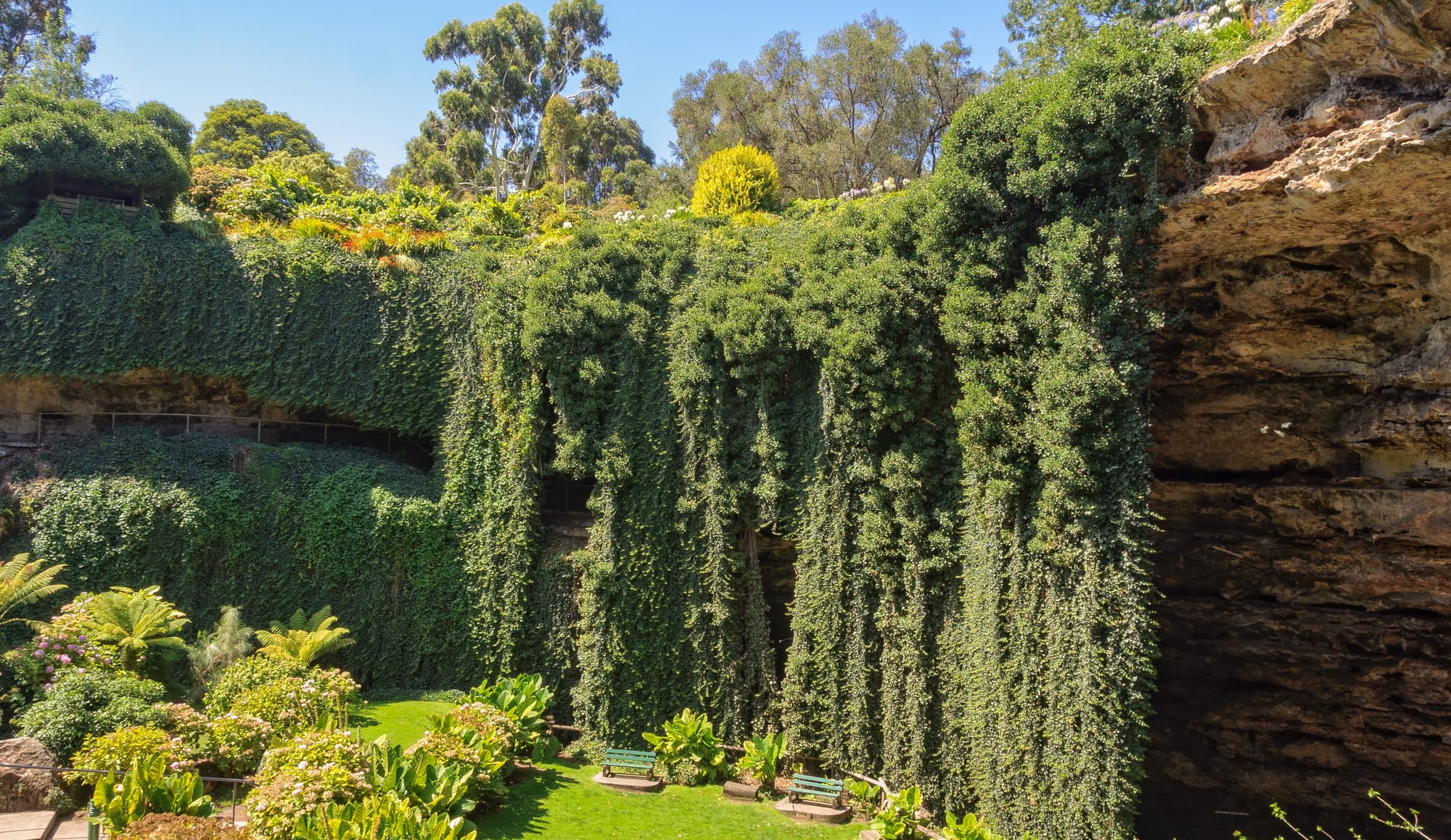
Mount Gambier is known for its deep crater lakes and sinkholes. It’s a unique spot to visit on your route to South Australia.
The Scenery
- Mount Gambier is famous for its volcanic landscapes—the city itself sits in an extinct volcanic crater.
- The Blue Lake is the showstopper—its water shifts to a brilliant cobalt blue each summer (November–March) before returning to steel-grey in winter.
- You’ll also find dramatic sinkholes like Umpherston Sinkhole, where gardens have been planted in collapsed limestone caves, and Engelbrecht Cave, which you can tour underground.
- Around the city, lush parklands, crater lakes, and fertile farmland add to the contrast of green against stone.
The Vibe
- Mount Gambier feels like a regional town with a strong connection to nature—you’re never far from a crater, cave, or lake.
- It’s laid-back, outdoorsy, and has a mix of heritage architecture, quirky local cafes, and a community that takes pride in its unique volcanic setting.
- Evenings are quiet, making it a great stop to reset in the middle of your road trip.
Day 20 — Arrival & Volcanic Wonders
- Morning: Arrive in Mount Gambier, check in to your stay, and start with the Blue Lake lookout circuit (driveable loop or walking trail).
- Midday: Head to Umpherston Sinkhole—walk among hanging gardens and resident possums (best spotted at dusk).
- Afternoon: Explore Cave Gardens, right in the city center, where waterfalls appear after heavy rain.
- Evening: Dinner in town—local favorites often highlight South Australian produce.
Day 21 — Caves, Coast & Wine (Optional Detours)
- Morning: Take a guided tour of Engelbrecht Cave, learning about its underground passageways and diving history.
- Late Morning: If you’re up for a short drive (30–40 minutes), head south to Port MacDonnell—a small fishing town known as the “Rock Lobster Capital of Australia.” Walk along the coast for rugged limestone cliffs.
- Afternoon: Visit Mount Schank, a volcanic crater you can hike into (~1 hour return for the rim walk).
- Alternative: Wine lovers can detour into the Coonawarra wine region (about 1 hour north) for famous cabernets and cellar doors.
- Evening: Return to Mount Gambier for a relaxed dinner. If time allows, revisit Umpherston Sinkhole to see it beautifully lit at night.
👉 Mount Gambier is both a natural highlight and a convenient midway point between the Grampians and the Great Ocean Road/Adelaide routes. Two days lets you enjoy its volcanic landmarks while leaving room for side trips to the coast or wine country.
Days 22–24:
Coorong National Park + Fleurieu Peninsula
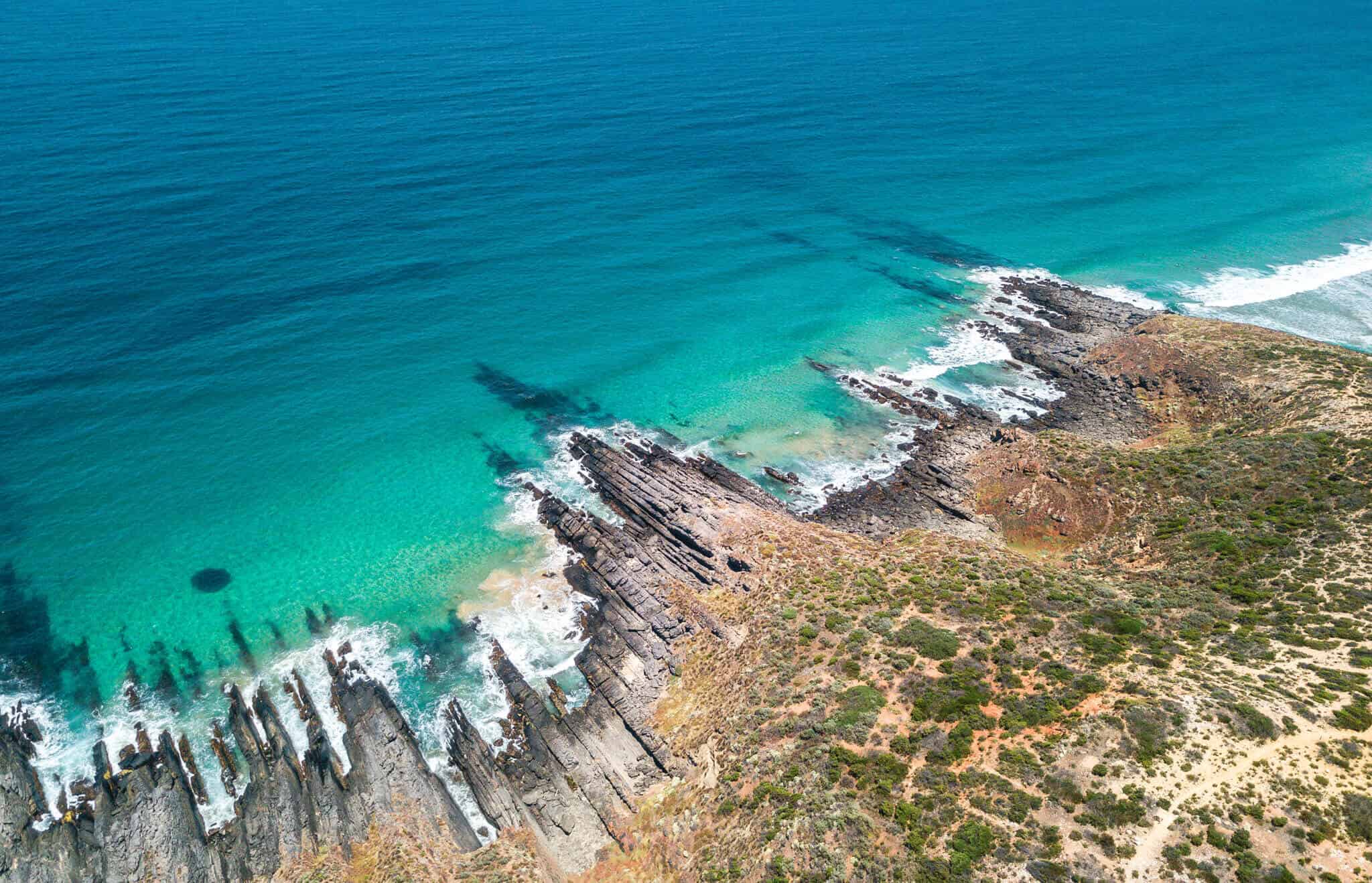
You’ll now head into wetlands, wild beaches, and rolling vineyards along South Australia’s southern coastline. This stretch is relaxed, scenic, and full of wildlife.
The Scenery
- The Coorong National Park stretches along South Australia’s coast, a mix of lagoons, wetlands, sand dunes, and birdlife. It’s remote, wild, and feels like you’ve stepped into a natural sanctuary.
- The Fleurieu Peninsula is a complete contrast—rolling vineyards, coastal cliffs, and some of the state’s most popular holiday beaches. Think surf breaks, wine country, and charming seaside towns.
- Together, these regions give you both untouched wilderness and coastal lifestyle vibes in just a short drive from Adelaide.
The Vibe
- Coorong: quiet, secluded, and deeply connected to Aboriginal culture—it’s about slowing down, birdwatching, fishing, and feeling small in a vast natural landscape.
- Fleurieu Peninsula: lively and indulgent—vineyard lunches, coastal drives, and easygoing beach towns where Adelaide locals escape on weekends.
- Both areas are about appreciating the outdoors—whether that’s kayaking through lagoons or sipping a glass of Shiraz overlooking a vineyard.
Day 22 — Coorong National Park
- Morning: Drive into Coorong National Park. Start with the Meningie Lookout and Pelican Observatory—great for spotting pelicans, black swans, and migratory birds.
- Midday: Go kayaking or take a guided eco-cruise through the Coorong lagoons to see the shifting sand dunes and saltwater wetlands up close.
- Afternoon: Stop at Long Point for fishing or a walk along the shoreline—this is where the lagoon meets sweeping sand flats.
- Evening: Stay overnight in or near the park. Stargazing is fantastic here thanks to minimal light pollution.
Day 23 — Fleurieu Peninsula Coast
- Morning: Drive west toward the Fleurieu. Begin at Victor Harbor, where you can cross the causeway to Granite Island (by foot or horse-drawn tram) for ocean views and, in season, whale watching.
- Midday: Head south to Port Elliot or Middleton Beach for swimming or surf lessons.
- Afternoon: Continue along the coast to Rapid Bay or Second Valley—dramatic cliffs, turquoise water, and excellent snorkeling spots.
- Evening: Overnight in Victor Harbor or one of the smaller coastal villages for a relaxed beach-town feel.
Day 24 — Wine & Hills of Fleurieu
- Morning: Shift inland to McLaren Vale, one of South Australia’s premier wine regions. Visit cellar doors—d’Arenberg’s Cube is a modern art-meets-wine landmark.
- Midday: Enjoy a long vineyard lunch with local produce and wine pairings. Many wineries have sweeping views over vines rolling toward the sea.
- Afternoon: If you’d like a break from wine, explore Onkaparinga River National Park with short hikes through gorges and river valleys.
- Evening: Either stay overnight in McLaren Vale or begin your drive north toward Adelaide, ready for the next leg of the journey.
Days 25–27:
Kangaroo Island
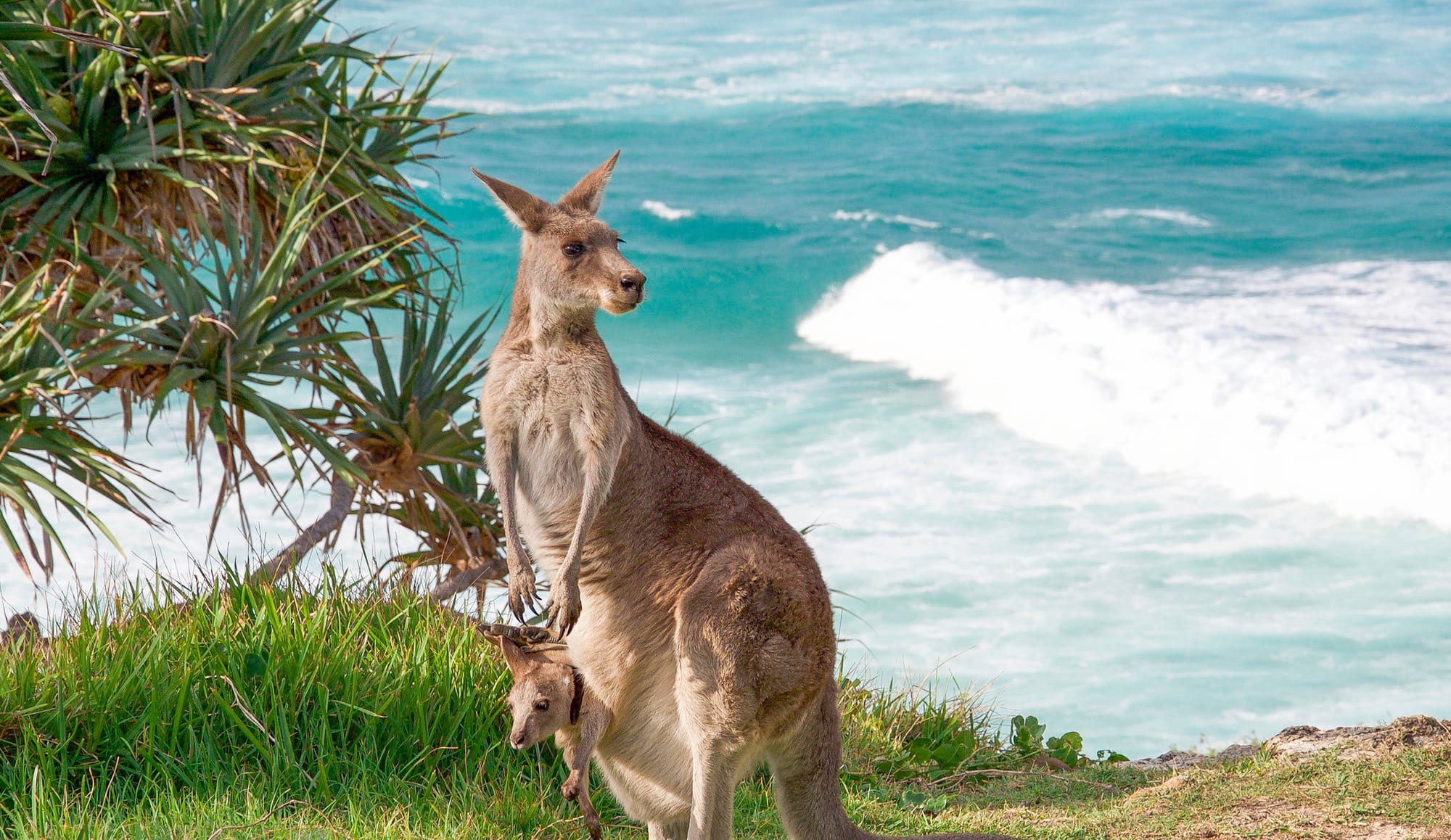
A short ferry brings you to one of Australia’s best wildlife destinations. See sea lions, kangaroos, and untouched coastal wilderness.
The Scenery
- Kangaroo Island feels like a world of its own—rugged coastlines, sweeping beaches, and wildlife-rich national parks.
- Expect dramatic rock formations like the Remarkable Rocks, wind-sculpted cliffs at Admirals Arch, and long, wild stretches of sand like Vivonne Bay.
- Inland, rolling farmland and eucalyptus forests give way to secluded coves and lagoons, while the turquoise waters offshore are home to dolphins, seals, and even whales in season.
The Vibe
- Remote, unspoiled, and laid-back—this is Australia’s nature island.
- You’ll find small towns with friendly locals, a strong food scene (think honey, seafood, and local wine), and plenty of space to unwind.
- Wildlife is the main star—kangaroos, koalas, sea lions, and echidnas all roam freely. It feels like an open-air zoo without fences.
Day 25 — Arrival & Wildlife Encounters
- Morning: Arrive by ferry from Cape Jervis or fly from Adelaide. Drive to Seal Bay Conservation Park—take a guided walk among a colony of Australian sea lions lounging on the sand.
- Midday: Continue to Raptor Domain for a birds-of-prey show, or visit Kangaroo Island Wildlife Park to see koalas, wombats, and kangaroos up close.
- Afternoon: Explore the south coast beaches—Vivonne Bay is often rated among Australia’s most beautiful.
- Evening: Overnight in Kingscote or a coastal cottage. Look out for wallabies and kangaroos grazing at dusk.
Day 26 — Flinders Chase National Park
- Morning: Head to the western end of the island for Flinders Chase National Park. Walk around the iconic Remarkable Rocks, where giant granite boulders balance dramatically on the headland.
- Midday: Visit Admirals Arch—a natural rock arch framed by crashing waves, often with fur seals basking nearby.
- Afternoon: Drive inland trails for wildlife spotting, or take the Platypus Waterholes Walk to try your luck at spotting elusive platypuses.
- Evening: Return to your accommodation or stay in an eco-lodge near the park for a deeper wilderness experience.
Day 27 — Coastal Flavors & Departure
- Morning: Visit Emu Bay for a final swim or beach walk, then stop at local producers:
- Island Pure Dairy (sheep’s milk cheese)
- Clifford’s Honey Farm (famous for Ligurian honey)
- Kangaroo Island Spirits (gin tasting).
- Midday: Enjoy a seafood lunch—marron (freshwater crayfish) and King George whiting are local specialties.
- Afternoon: Drive back toward Penneshaw for the ferry, or to Kingscote Airport for your return flight to Adelaide.
Days 28–30:
Adelaide & Barossa Valley
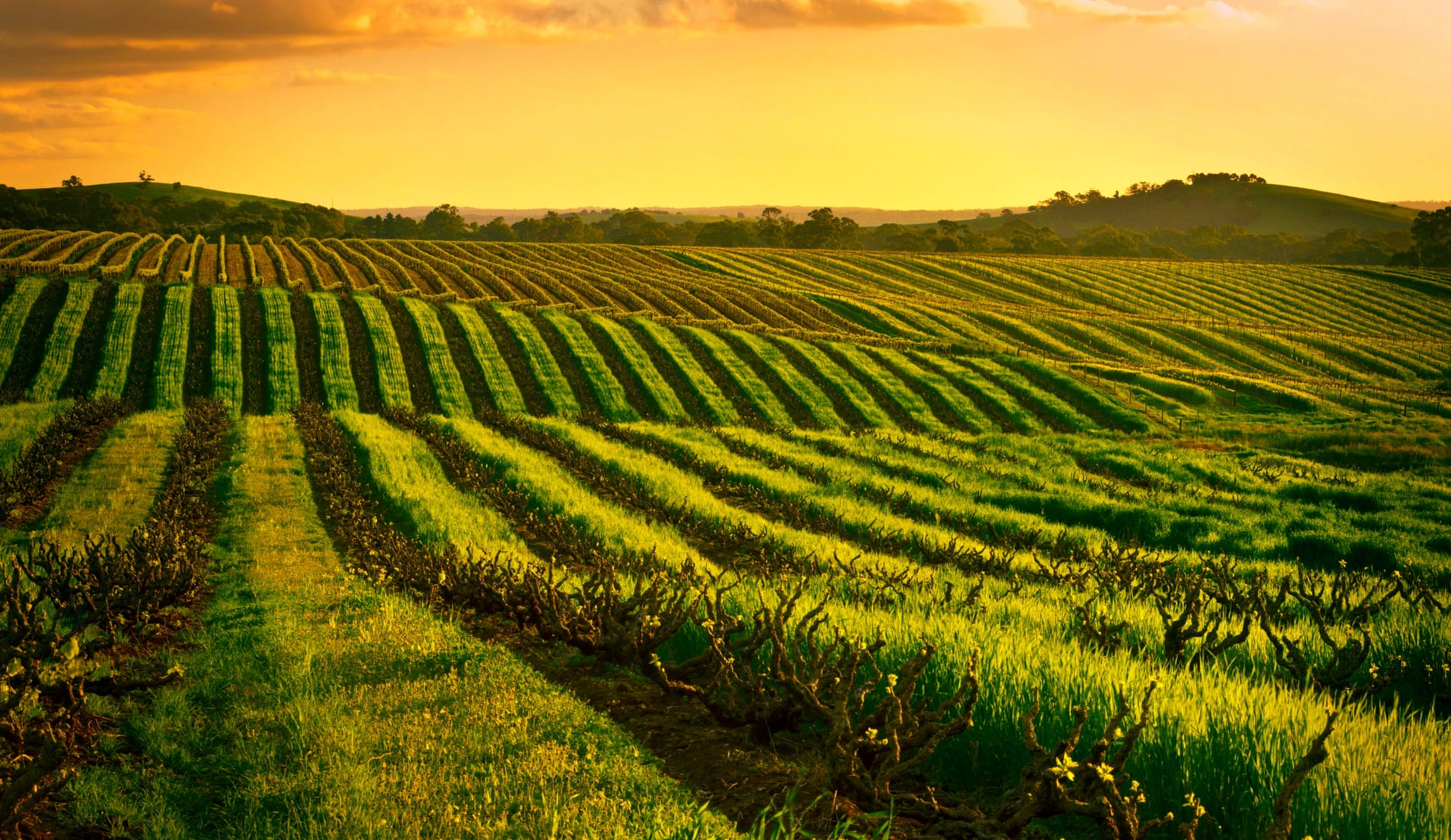
Wrap up your journey in Adelaide and the nearby wine country. These last few days are about food, culture, and celebration.
The Scenery
- Adelaide is framed by the rolling Adelaide Hills to the east and sandy beaches to the west.
- The city itself has leafy parklands wrapped around its center, a grid of wide streets, and historic sandstone buildings that give it charm.
- Within an hour, you can be wine tasting in world-class regions like the Barossa Valley or McLaren Vale, or relaxing on the coast at Glenelg.
The Vibe
- Relaxed and easygoing—Adelaide feels like a big country town with city perks.
- It has a thriving food and arts scene, outdoor dining squares, bustling markets, and a café culture that rivals Melbourne.
- It’s also a perfect gateway city—everything feels close, from wine country to beaches to wildlife.
Day 28 — City & Coast
- Morning: Stroll through the Adelaide Central Market, one of the largest undercover markets in the Southern Hemisphere, filled with fresh produce, artisan cheeses, and multicultural eats.
- Midday: Walk the leafy streets of North Terrace—visit the Art Gallery of South Australia or the South Australian Museum.
- Afternoon: Take a tram from the city to Glenelg Beach for a swim, seaside dining, and a sunset stroll along the jetty.
- Evening: Return to the city for dinner in Leigh Street or Peel Street, both known for trendy bars and restaurants.
Day 29 — Wine & Hills
- Morning: Head out to the Barossa Valley or McLaren Vale for a day of wine tasting. The Barossa is known for its bold Shiraz, while McLaren Vale shines with boutique wineries and coastal views.
- Midday: Enjoy a winery lunch—many estates serve gourmet meals overlooking vineyards.
- Afternoon: Stop in the Adelaide Hills on your way back—explore Hahndorf, a German heritage village filled with bakeries, pubs, and boutique shops.
- Evening: Wrap up your trip with a final dinner in Adelaide, perhaps trying local specialties like King George whiting or Coorong mullet.
Day 30 — The Journey Home
Sadly, all great things must come to an end! Until your next adventure my friend.
Transportation Tip
This trip mixes flights and self-driving. If you're wanting to drive the entire trip you will obviously need to extend this itinerary by a few days to make up for the extra time that you will lose driving.
How Long Does It Take to Drive from Darwin to Adelaide Along the Eastern Coast of Australia?
If you were to drive from Darwin to Adelaide via the eastern coastline—passing through Cairns, Brisbane, Sydney, and Melbourne—you’d cover roughly 3,270 miles.
🚗 Total Drive Time: Approximately 59.5 hours (A long da*n way). For context, it takes 40-45 hours to drive across the United States.
While the Whitsundays would still require a flight due to its offshore location, the rest of the route can be driven. So if you're planning to do this itinerary entirely by road, it's good to know the drive time in advance—just make sure to allow enough days in your schedule to enjoy the journey without feeling rushed.
Not A Member? ✈️
Save 40%-95% On Flights With Jetsetter Alerts Airline Mistake Fare & Flash Sales Alerts!


